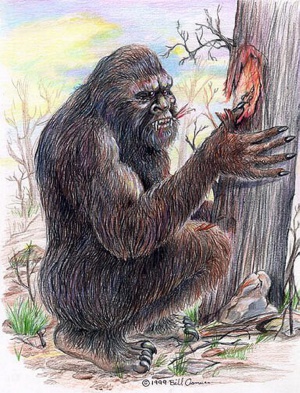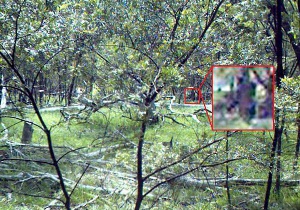(Other hominoid) Yowie
In a modern context, Yowie is the generic (and somewhat affectionate) term for the unidentified hominid reputed to lurk in the Australian wilderness. It is an Australian cryptid analogous to the Himalayan Yeti and the North American Bigfoot.
Rather confusingly, Yowie (or "Yowie-Whowie") is also the name of a completely different mythological character in native Australian Aboriginal folklore. This version of the Yowie is said to be a bizarre, hybrid beast resembling a cross between a lizard and an ant. It emerges from the ground at night to eat whatever it can find, including humans. This creature's characteristics and legend are sometimes interchangeable with those of the bunyip.
The origin of the term "Yowie" in the context of unidentified hominids is unclear. Some presume that it simply arose through confusion with the aforementioned Aboriginal legend. On the other hand, Jonathan Swift's yahoos from Gulliver's Travels are sometimes cited as a source. The word "Yowie" was also apparently a slang term for the Orang-utan in Victorian England.
The earliest published reference to the word in its current usage is in Donald Friend's Hillendiana a collection of writing about the goldfields near Hill End in New South Wales. Friend refers to the "Yowie" as a species of "bunyip", an Aboriginal term used to describe monsters said to dwell in many Australian rivers and lakes. Researcher Rex Gilroy popularised the word in newspaper articles during the 1970s and 1980s.
Contents
- Sightings and reports
- Candidates
Sightings and reports
Reports of Yowie-type creatures are common in the legends and stories of Australian Aboriginal tribes, particularly those of the eastern states of Australia (Healy & Cropper, p.6). The mid to late 19th Century saw a wealth of sightings, most describing a large, gorilla-like creature (albeit usually bipedal), which lived in remote mountainous or forested regions. Reports have continued to the present day with the trail of evidence following the pattern familiar to most unidentified hominids around the world – i.e. eyewitness accounts, mysterious footprints of hotly-disputed origin, and a frustrating lack of conclusive proof.
Candidates
Self-proclaimed Australian cryptozoologist Rex Gilroy has attempted to popularise the scientific term Gigantopithecus australis for the yowie. He claims to have collected over 3000 reports of them and proposed that they comprise a relict population of extinct ape or Homo species. There is, however, no evidence that Gigantopithecus ever existed in Australia.
According to Wayne Smith the Yowie Hunter, who has studied Palaeontology, the genus of ape called Gigantopithecus lived from 5 million years ago to perhaps 100,000 years ago. If small isolated communities had survived to the present time in Australia then it's quite possible that their remains might have been missed over the last two centuries since European colonisation. Wayne says that such animals might be fringe dwellers driven to inhabiting difficult terrain by the aboriginal inhabitants who largely replaced them.
Several Murri and Koori tribes of eastern Australia have dreamtime legends about an ancient battle between their ancestors and a race of hairy apemen. The stories share some common elements. The aboriginals won the battle quite decisively. This is attributed to their weapons including the spear and war boomerang. The apemen fought bare handed. The surviving creatures ran off to the mountains from which they occasionally invaded the forests to steal human babies.

